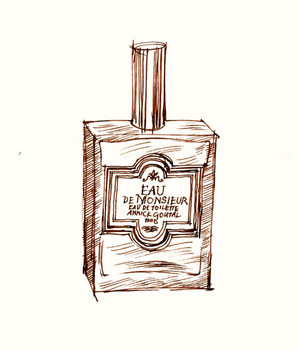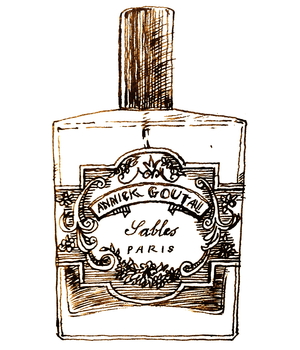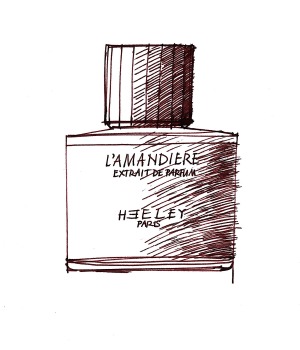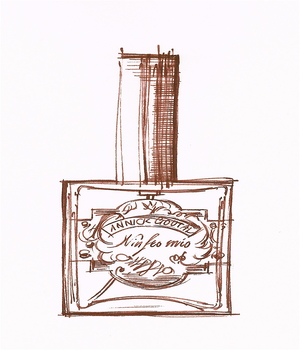Tagged With ‘“Annick Goutal”’
Annick Goutal
Eau de Monsieur
26 March, 2015
 Mention the name Annick Goutal and the first scent that springs to mind is Eau d’Hadrien, the intensely lemony, slightly hair-sprayish scent that was launched in 1981 and went on to become the company’s best-seller.
Mention the name Annick Goutal and the first scent that springs to mind is Eau d’Hadrien, the intensely lemony, slightly hair-sprayish scent that was launched in 1981 and went on to become the company’s best-seller.
But before Eau d’Hadrien came Eau de Monsieur. Launched in 1980, discontinued for a while and then relaunched in 2013, it shares its lemony, eau de cologne-like zest with Eau d’Hadrien, but it’s an altogether quieter, softer fragrance.
Eau de Monsieur, like Eau d’Hadrien, is based around the zesty, zingy smell of lemons and the slightly pear-drop-lemony sweetness of lemon verbena (extracted from the leaves of a straggly South American shrub).
But while that’s pretty much the start and the finish of Eau d’Hadrien, that initial burst of sharp sweet freshness quickly fades to reveal what smells a bit like a sun-drenched Greek mountainside underneath – that scent of crushed thyme, cistus leaves and lavender, which in this case has an added touch of helichrysum, that strong-smelling everlasting flower that the French call immortelle.
Immortelle isn’t a scent that everybody loves: to me it has the richness of brandy and Christmas pudding and crackling pine-log fires, but to other people it has a medicinal TCP smell, which isn’t something you necessarily want in a perfume.
In Goutal’s fantastic Sables, released a few years later in 1985, immortelle is the main ingredient, but in Eau de Monsieur it’s used in moderation to give a subtle background sweetness. According to the list of ingredients on the Annick Goutal website, it also includes patchouli and sandalwood, which add a bit of their gentle warm woodiness to the mix, and there’s a little bit of bitterness too, which other writers have ascribed to that classic men’s-fragrance ingredient, vetiver.
It’s not, perhaps, the most original perfume out there, and it’s disappointing to discover that it only last an hour or so on the skin, but Eau de Monsieur is classy, attractive, natural-smelling and easy to wear, which is a lot more than you can say for the majority of men’s fragrances.
Annick Goutal
Sables
5 February, 2015
 Once you’ve smelled a lot of perfumes you start to realise when a scent is cheap and nasty – even on the occasions when it’s got a huge advertising budget and everyone seems to be buying it. (Why? Well, a lot of people still get swept up by advertising, but you can be fairly sure they’ll only buy it once.)
Once you’ve smelled a lot of perfumes you start to realise when a scent is cheap and nasty – even on the occasions when it’s got a huge advertising budget and everyone seems to be buying it. (Why? Well, a lot of people still get swept up by advertising, but you can be fairly sure they’ll only buy it once.)
But even among the most brilliantly put-together perfumes each person’s individual reaction counts for a lot. Smell taps in to such deeply rooted – and often subconscious – memories and associations for each of us that two people can have completely different gut-reactions to the same scent.
And not only that: it actually smells completely different to each of them, even though their brain is presumably processing the same elements in a fairly similar way. Most scientists seem to agree that, unless we suffer from particularly severe sight problems, the way I see Hèrmes orange is almost certainly the same as the way you see it.
Smell, though, appears to work in a rather different manner. We may well smell the same scents in the same objective way, but the personal associations that specific scents have for us seem to be more powerful than what we actually smell – conceivably for the simple reason that we have such trouble describing them in words.
Here’s a perfect example. Sables was first launched by the late, great French perfumer Annick Goutal in 1985, and though it was withdrawn from the UK market some time ago in one of those mysterious overnight disappearances that give the perfume industry its faint whiff of Stalinism, it can still be bought online and abroad.
Sables is one of my all-time favourite fragrances. Though its name is meant to evoke the high-summer sexiness of sun-baked sand, this fantastically rich, sweetly luxurious scent smells, to me, of all the best things about Christmas – vintage oloroso sherry, mince pies, the delicious heat of an applewood log fire, flaming brandy, Christmas pudding… All very positive associations, as far as I’m concerned.
I’d be the first to admit that Sables is strong stuff, best suited to opulent winter evenings; apply it too liberally and, like Guerlain’s L’heure bleue or Chanel’s No22, it can easily become overpowering. But while I can imagine choking on No22 in too high a concentration, to be overcome by Sables would, for me at least, be like drowning in a butt of Malmsey – frankly not a bad way to go.
To a friend who knows at least as much about perfume as I do, though, Sables has an unattractively medicinal smell with none of the enchanting connotations that give it such a deep and lasting appeal for me. I can (kind of) see what he’s getting at, and if I try hard I can just about identify a hint of cough-mixture about it, but for some reason that association, in my mind, is completely drowned out by all the good stuff I’ve already mentioned.
The moral? I’m not sure there is one, but I guess it’s always good to remember there’s no guarantee that everyone is going to share your passion for a particular perfume, no matter how wonderful it smells to you.
Heeley
L’Amandière
19 November, 2014

Well-heeled and well-spoken, with a passing resemblance to the young Bruce Chatwin, James Heeley is a Paris-based product designer and perfumer. We’re told that he was born in Yorkshire, studied philosophy in London and then worked as a lawyer, before moving to Paris in the late 1990s, where he changed tack again and began designing vases for star French florist Christian Tortu.
Through Tortu he met Annick Goutal, the legendary pianist turned model turned independent perfumer, which must have been an inspiring introduction to the world of perfume. Heeley describes himself as a self-taught perfumer, and though he commissioned his first few fragrances he now creates the initial olfactory compositions himself.
At £170 for a 50ml bottle of ‘Extrait de parfum’ (which you can buy online from Les Senteurs), L’Amandière is breathtakingly expensive, but at least it has the grace to look like it, coming in a bottle whose surprisingly hefty weight belies its size. Its design is crisp and simple, as you’d hope from a product designer, with a simple black label and a chunky black faceted cap.
Heeley calls his latest fragrance ‘a portrait of spring’, and adds ‘I tried to include many of the scents that my girlfriend loves (including almond) and assemble them to create an imaginary, spring orchard.’ He may have intended it as a woman’s perfume, but what you smell first is light and rather refreshing combination of almond oil and fresh-cut grass – both of which have hints of bitterness (in almond’s case) and sourness (in the case of green grass), which prevents L’Amandière coming across as too floral and girly.
It does have its floral side thanks to the pastel softness of mimosa, but because the almond scent predominates in the end its associations end up reminding one more of food than flowers – though without the cloying sweetness of other food-related fragrances like vanilla or chocolate.
On a woman I think it would smell perfectly pleasant, but on a man it’s much more interesting and unusual, which is why I’m recommending it here. It has surprisingly good staying-power too, which is a good thing given how much each spray has cost you. One for the connoisseur.
Annick Goutal
Ninfeo Mio
2 August, 2014
 This is the second time I’ve stumbled across a delicious perfume in, of all places, TK Maxx. I know I should be saving up and buying beautifully wrapped bottles from expensive boutiques, but for a start I don’t earn much and, second, I rather like the occasional gamble on a discounted scent that might just turn out to be fab.
This is the second time I’ve stumbled across a delicious perfume in, of all places, TK Maxx. I know I should be saving up and buying beautifully wrapped bottles from expensive boutiques, but for a start I don’t earn much and, second, I rather like the occasional gamble on a discounted scent that might just turn out to be fab.
That’s certainly the case with Ninfeo Mio, a small bottle of which I picked up for a song a little while ago. I’m a bit of an Annick Goutal fan, mainly for the powerful, love-it-or-hate-it Sables, but also for the better-known Eau d’Hadrien, so Ninfeo Mio seemed worth a bet – and I’m glad I took a punt.
This unisex perfume was launched in 2009 and created by Isabelle Doyen, who was Annick Goutal’s assistant, and took over the development of new perfumes after Goutal’s death in 1999. The first thing you smell is fig, and actually that’s pretty much the last thing you smell too, and that would be just fine and dandy with me, since fig is a scent I love – both the natural thing and figtastic perfumes like Premier Figuier from L’Artisan Parfumeur and Philosykos from Diptyque.
But the fig in Ninfeo Mio is mixed with lemon and lavender, musk and hedione, the chemical that gives Eau Sauvage much of its particular magic. These add to the character of the scent, but I think they also accentuate the figginess of the fig, which is fresh and green and slightly sweet but also a little bit dirty, with something of the sexiness of fresh sweat. It’s not, perhaps, as refined a perfume as Premier Figuier, but I love its in-your-face earthiness.
As is so often the case, the name and the marketing ‘story’ came after the scent, or at least after it was begun. It refers to the much mooned-over gardens of Ninfa in the once-malarial marshlands south-east of Rome, which (luckily for Isbelle Doyen) turned out to be full of lemon-trees, lavender and figs. The perfume would probably have been called Ninfa Mia except that the name ‘Ninfa’ had already been copyrighted, so the more masculine Ninfeo Mio it is.